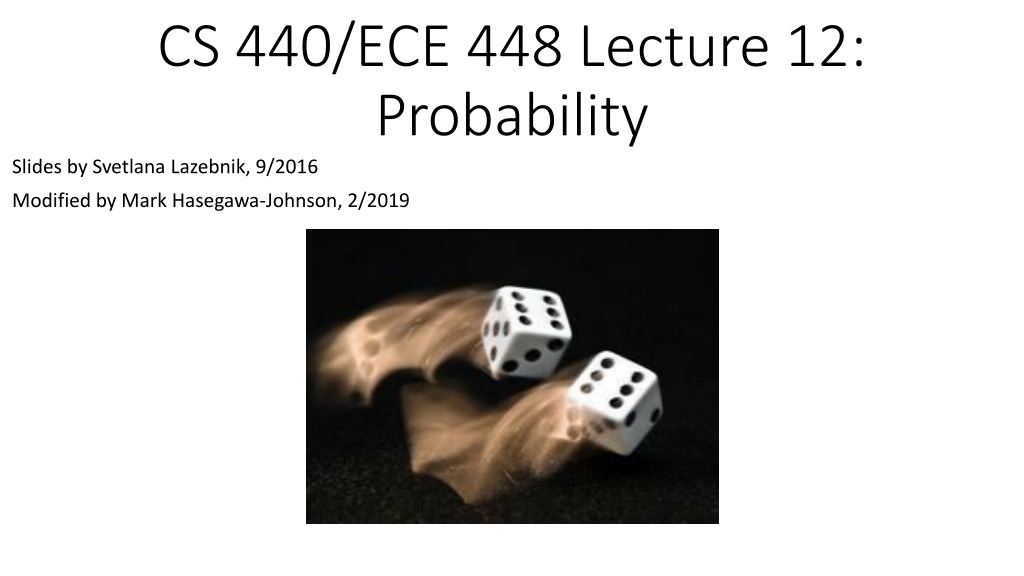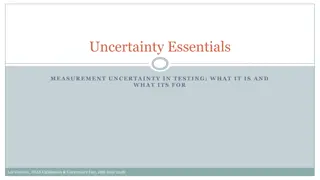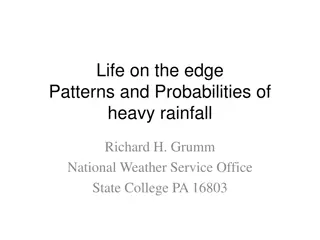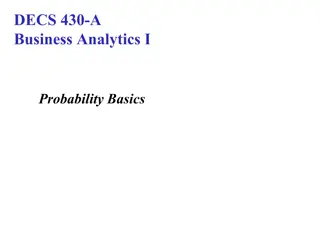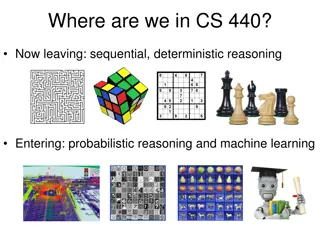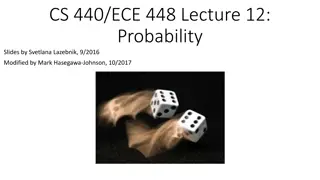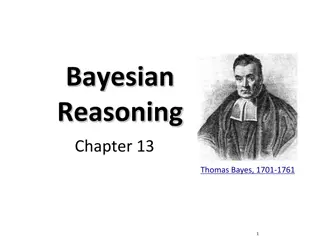Understanding Probability and Decision Making Under Uncertainty
Probability theory plays a crucial role in decision-making under uncertainty. This lecture delves into key concepts such as outcomes, events, joint probabilities, conditional independence, and utility theory. It explores how to make decisions based on probabilities and expected utility, highlighting the importance of modeling unknown events and assigning belief values. The discussion covers the origins of probabilities, including frequentism and subjectivism, and how they relate to decision theory and representing preferences.
Download Presentation

Please find below an Image/Link to download the presentation.
The content on the website is provided AS IS for your information and personal use only. It may not be sold, licensed, or shared on other websites without obtaining consent from the author. Download presentation by click this link. If you encounter any issues during the download, it is possible that the publisher has removed the file from their server.
E N D
Presentation Transcript
CS 440/ECE 448 Lecture 12: Probability Slides by Svetlana Lazebnik, 9/2016 Modified by Mark Hasegawa-Johnson, 2/2019
Outline Motivation: Why use probability? Review of Key Concepts Outcomes, Events Joint, Marginal, and Conditional Independent vs. Conditionally Independent events Classification Using Probabilities
Outline Motivation: Why use probability? Review of Key Concepts Outcomes, Events Joint, Marginal, and Conditional Independence and Conditional Independence Classification Using Probabilities
Motivation: Planning under uncertainty Recall: representation for planning States are specified as conjunctions of predicates Start state: At(Me, UIUC) TravelTime(35min,UIUC,CMI) Now(12:45) Goal state: At(Me, CMI, 15:30) Actions are described in terms of preconditions and effects: Go(t, src, dst) Precond: At(Me,src) TravelTime(dt,src,dst) Now( t) Effect: At(Me, dst, t+dt)
Making decisions under uncertainty Suppose the agent believes the following: P(Go(deadline-25) gets me there on time) = 0.04 P(Go(deadline-90) gets me there on time) = 0.70 P(Go(deadline-120)gets me there on time) = 0.95 P(Go(deadline-180) gets me there on time) = 0.9999 Which action should the agent choose? Depends on preferences for missing flight vs. time spent waiting Encapsulated by a utility function The agent should choose the action that maximizes the expected utility: Prob(A succeeds) Utility(A succeeds) + Prob(A fails) Utility(A fails)
Making decisions under uncertainty More generally: the expected utility of an action is defined as: E[Utility|Action] = ????????? ??????? ?????? ???????(???????) Utility theory is used to represent and infer preferences Decision theory = probability theory + utility theory
Where do probabilities come from? Frequentism Probabilities are relative frequencies For example, if we toss a coin many times, P(heads) is the proportion of the time the coin will come up heads But what if we re dealing with an event that has never happened before? What is the probability that the Earth will warm by 0.15 degrees this year? Subjectivism Probabilities are degrees of belief But then, how do we assign belief values to statements? In practice: models. Represent an unknown event as a series of better- known events A theoretical problem with Subjectivism: Why do beliefs need to follow the laws of probability?
The Rational Bettor Theorem Why should a rational agent hold beliefs that are consistent with axioms of probability? For example, P(A) + P( A) = 1 Suppose an agent believes that P(A)=0.7, and P( A)=0.7 Offer the following bet: if A occurs, agent wins $100. If A doesn t occur, agent loses $105. Agent believes P(A)>100/(100+105), so agent accepts the bet. Offer another bet: if A occurs, agent wins $100. If A doesn t occur, agent loses $105. Agent believes P( A)>100/(100+105), so agent accepts the bet. Oops Theorem: An agent who holds beliefs inconsistent with axioms of probability can be convinced to accept a combination of bets that is guaranteed to lose them money
Outline Motivation: Why use probability? Review of Key Concepts Outcomes, Events Joint, Marginal, and Conditional Independence and Conditional Independence Classification Using Probabilities
Events Probabilistic statements are defined over events, or sets of world states A = It is raining B = The weather is either cloudy or snowy C = I roll two dice, and the result is 11 D = My car is going between 30 and 50 miles per hour An EVENT is a SET of OUTCOMES B = { outcomes : cloudy OR snowy } C = { outcome tuples (d1,d2) such that d1+d2 = 11 } Notation: P(A) is the probability of the set of world states (outcomes) in which proposition A holds
Kolmogorovs axioms of probability For any propositions (events) A, B 0 P(A) 1 P(True) = 1 and P(False) = 0 P(A B) = P(A) + P(B) P(A B) Subtraction accounts for double-counting A B B A Based on these axioms, what is P( A)? These axioms are sufficient to completely specify probability theory for discrete random variables For continuous variables, need density functions
Outcomes = Atomic events OUTCOME or ATOMIC EVENT: is a complete specification of the state of the world, or a complete assignment of domain values to all random variables Atomic events are mutually exclusive and exhaustive E.g., if the world consists of only two Boolean variables Cavity and Toothache, then there are four outcomes: Outcome #1: Cavity Toothache Outcome #2: Cavity Toothache Outcome #3: Cavity Toothache Outcome #4: Cavity Toothache
Outline Motivation: Why use probability? Review of Key Concepts Outcomes, Events Joint, Marginal, and Conditional Independence and Conditional Independence Classification Using Probabilities
Joint probability distributions A joint distribution is an assignment of probabilities to every possible atomic event Atomic event Cavity Toothache Cavity Toothache Cavity Toothache Cavity Toothache P 0.8 0.1 0.05 0.05 Why does it follow from the axioms of probability that the probabilities of all possible atomic events must sum to 1?
Joint probability distributions Suppose we have a joint distribution of N random variables, each of which takes values from a domain of size D: What is the size of the probability table? Impossible to write out completely for all but the smallest distributions
Marginal distributions The marginal distribution of event Xk is just its probability, P(Xk). If you re given the joint distribution, P(X1, X2, , XN) , from it, how can you calculate P(Xk)? You calculate P(Xk) from P(X1, X2, , XN) by marginalizing.
Marginal probability distributions From the joint distribution p(X,Y) we can find the marginal distributions p(X) and p(Y) P(Cavity, Toothache) Cavity Toothache Cavity Toothache Cavity Toothache Cavity Toothache 0.8 0.1 0.05 0.05 P(Cavity) P(Toothache) Cavity 0.9 Toothache 0.85 Cavity 0.1 Toochache 0.15
Conditional distributions The conditional probability of event Xk, given event Xj, is the probability that Xk has occurred if you already know that Xj has occurred. The conditional distribution is written P(Xk| Xj). The probability that both Xj and Xk occurred was, originally, P(Xj, Xk). But now you know that Xj has occurred. So all of the other events are no longer possible. Other events: probability used to be P( Xj), but now their probability is 0. Events in which Xj occurred: probability used to be P(Xj), but now their probability is 1. So we need to renormalize: the probability that both Xj and Xk occurred, GIVEN that Xj has occurred, is P(Xk| Xj)=P(Xj, Xk)/P(Xj).
Conditional Probability: renormalize (divide) Probability of cavity given toothache: P(Cavity = true | Toothache = true) ( P ) ( P , B ) P A B P A B For any two events A and B, = = ( | ) P A B ( ) ( ) B Now that we know B has occurred, the set of all possible events = the set of events in which B occurred. So we renormalize to make the area of this circle = 1. P(A B) The set of all possible events used to be this rectangle, so the whole rectangle used to have probability=1. P(A) P(B)
Conditional probability P(Cavity, Toothache) Cavity Toothache Cavity Toothache Cavity Toothache Cavity Toothache 0.8 0.1 0.05 0.05 P(Cavity) P(Toothache) Cavity 0.9 Toothache 0.85 Cavity 0.1 Toochache 0.15 What is p(Cavity = true | Toothache = false)? p(Cavity| Toothache) = 0.05/0.85 = 1/17 What is p(Cavity = false | Toothache = true)? p( Cavity|Toothache) = 0.1/0.15 = 2/3
Conditional distributions A conditional distribution is a distribution over the values of one variable given fixed values of other variables P(Cavity, Toothache) Cavity Toothache Cavity Toothache Cavity Toothache Cavity Toothache 0.8 0.1 0.05 0.05 P(Cavity | Toothache) P(Cavity| Toothache) Cavity 0.667 Cavity 0.941 Cavity 0.333 Cavity 0.059 P(Toothache | Cavity) P(Toothache | Cavity) Toothache 0.5 Toothache 0.889 Toochache 0.5 Toochache 0.111
Normalization trick To get the whole conditional distribution p(X | Y = y) at once, select all entries in the joint distribution table matching Y = y and renormalize them to sum to one P(Cavity, Toothache) Cavity Toothache Cavity Toothache Cavity Toothache Cavity Toothache 0.8 0.1 0.05 0.05 Select Toothache, Cavity = false 0.8 Toothache 0.1 Toochache Renormalize P(Toothache | Cavity = false) 0.889 Toothache 0.111 Toochache
Normalization trick To get the whole conditional distribution p(X | Y = y) at once, select all entries in the joint distribution table matching Y = y and renormalize them to sum to one Why does it work? ( P , x ) ( , y ) P x y P x y = P(x|y)= by marginalization ( , ) ( ) y P x
Product rule ( P , B ) P A B = ( | ) P A B Definition of conditional probability: ( ) Sometimes we have the conditional probability and want to obtain the joint: = = ( , ) ( | ) ( ) ( | ) ( ) P A B P A B P B P B A P A The chain rule: = ( , , ) ( ) ( | ) ( | , ) ( | , , ) P A A P A P A A P A A A P A A A 1 1 2 1 3 1 2 1 1 n n n n = i = ( | , , ) P A A A 1 1 i i 1
Outline Motivation: Why use probability? Review of Key Concepts Outcomes, Events, and Random Variables Joint, Marginal, and Conditional Independence and Conditional Independence Classification Using Probabilities
Independence Mutually Exclusive Two events A and B are independent if and only if p(A B) = p(A, B) = p(A) p(B) In other words, p(A | B) = p(A) and p(B | A) = p(B) This is an important simplifying assumption for modeling, e.g., Toothache and Weather can be assumed to be independent? Are two mutually exclusive events independent? No! Quite the opposite! If you know A happened, then you know that B _didn t_ happen!! p(A B) = p(A) + p(B)
Independence Conditional Independence Cavity: Boolean variable indicating whether the patient has a cavity Toothache: Boolean variable indicating whether the patient has a toothache Catch: whether the dentist s probe catches in the cavity By Aduran, CC-SA 3.0 By William Brassey Hole(Died:1917) By Dozenist, CC-SA 3.0
These Events are not Independent If the patient has a toothache, then it s likely he has a cavity. Having a cavity makes it more likely that the probe will catch on something. ?(???? |???? ?? ?) > ?(???? ) If the probe catches on something, then it s likely that the patient has a cavity. If he has a cavity, then he might also have a toothache. ?(???? ?? ?|???? ) > ?(???? ?? ?) So Catch and Toothache are not independent
but they are Conditionally Independent Dependent Dependent Conditionally Dependent given knowledge of Cavity Here are some reasons the probe might not catch, despite having a cavity: The dentist might be really careless The cavity might be really small Those reasons have nothing to do with the toothache! ? ???? ??????,???? ?? ? = ?(???? |??????) Catch and Toothache are conditionally independent given knowledge of Cavity
but they are Conditionally Independent Dependent Dependent Conditionally Dependent given knowledge of Cavity These statements are all equivalent: ? ???? ??????,???? ?? ? = ? ???? ?????? ? ???? ?? ? ??????,???? = ?(???? ?? ?|??????) ? ???? ?? ?,???? ?????? = ?(???? ?? ?|??????)? ???? ?????? and they all mean that Catch and Toothache are conditionally independent given knowledge of Cavity
Outline Motivation: Why use probability? Review of Key Concepts Outcomes, Events Joint, Marginal, and Conditional Independent vs. Conditionally Independent events Classification Using Probabilities
Classification using probabilities Suppose you know that you have a toothache. Should you conclude that you have a cavity? Goal: make a decision that minimizes your probability of error. Equivalent: make a decision that maximizes the probability of being correct. This is called a MAP (maximum a posteriori) decision. You decide that you have a toothache if and only if ? ?????? ???? ?? ? > ?( ??????|???? ?? ?)
Bayesian Decisions What if we don t know ? ?????? ???? ?? ? ? Instead, we only know ? ???? ?? ? ?????? ,?(??????), and ?(???? ?? ?)? Then we choose to believe we have a Cavity if and only if ? ?????? ???? ?? ? > ?( ??????|???? ?? ?) Which can be re-written as ? ???? ?? ? ?????? ?(??????) ?(???? ?? ?) >? ???? ?? ? ?????? ?( ??????) ?(???? ?? ?)
Outline Motivation: Why use probability? Review of Key Concepts Outcomes, Events Joint, Marginal, and Conditional Independent vs. Conditionally Independent events Classification Using Probabilities
